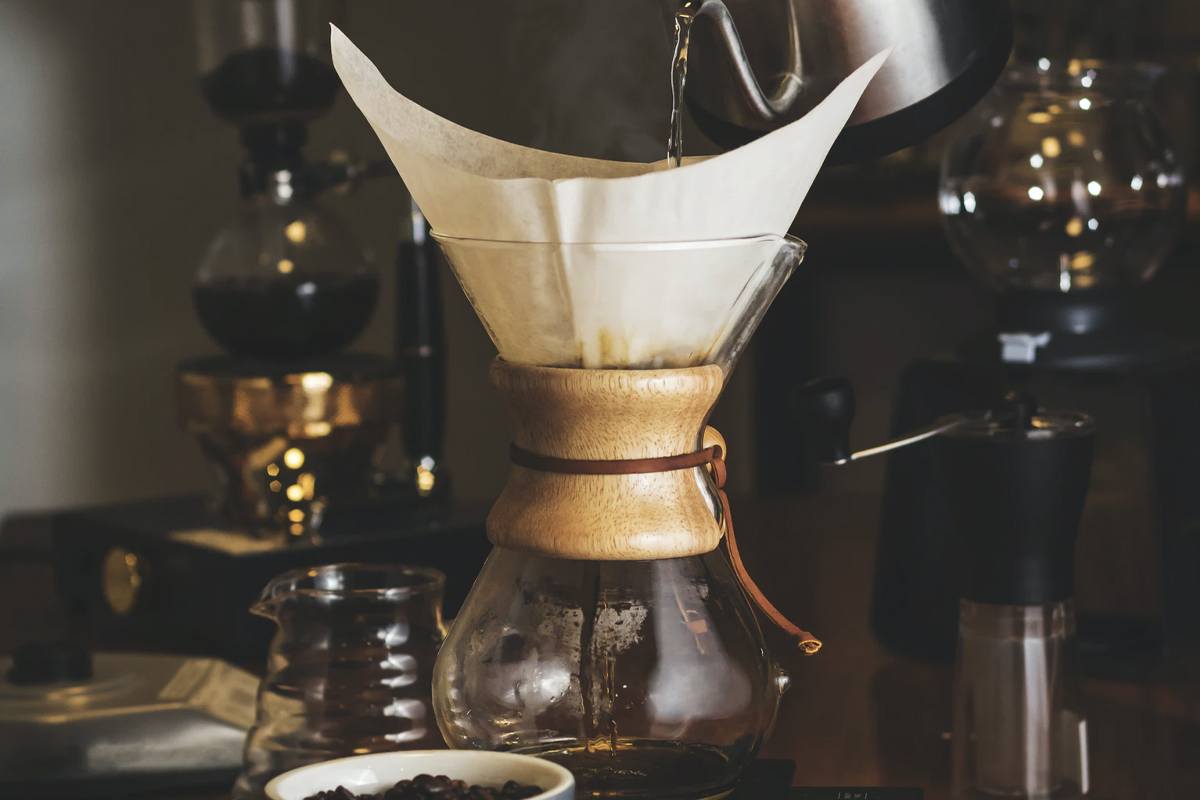If you don’t have a pour-over coffee maker, do you even brew coffee? Don’t fret, pour-over coffee is a daunting brewing process to get the hang of; you may have to brew a few bad cups of coffee before uncovering the secret to a decent one. Creating the best cup of coffee is a practice, an art form, a therapeutic morning ritual. And the best pour-over brews start with the best pour-over coffee maker.
Dive into our guide about making the best pour-over coffee and the best tools to make it and read on as we give you a step-by-step tutorial on how you can brew like a barista.
The Best Pour-Over Coffee Makers
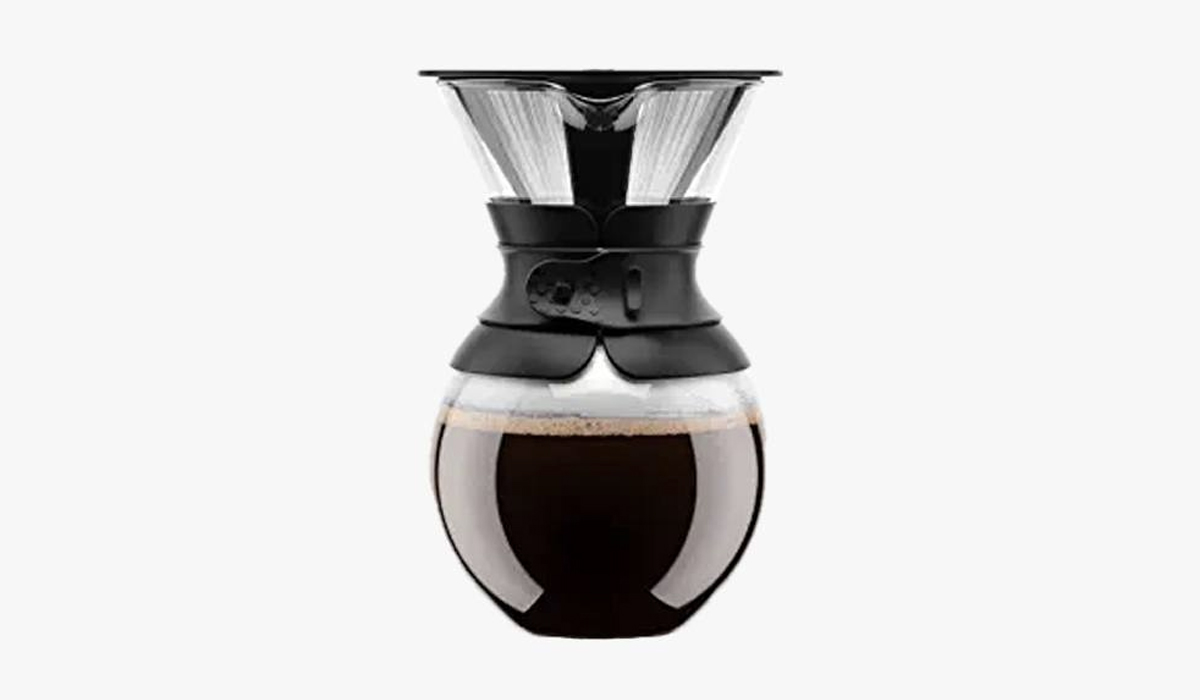
Bodum Pour Over Coffee Maker (BEST CHOICE)
Our best choice is the Bodum Pour-over Coffee Maker. It is a stainless steel filter with a BPA-free plastic frame. The pour-over device is removable from an hourglass decanter once the brewing process finishes, and you can serve your guest in style.
You do not need paper filters with this stainless steel filter. Saving you money and flavor; it will not rob your coffee of subtle flavor notes and smells that a paper filter tends to do. The glass decanter is durable, heat-resistant borosilicate glass and can hold 34 ounces of coffee. This coffee maker is dishwasher safe with a removable plastic cuff to protect your hands from the heat.
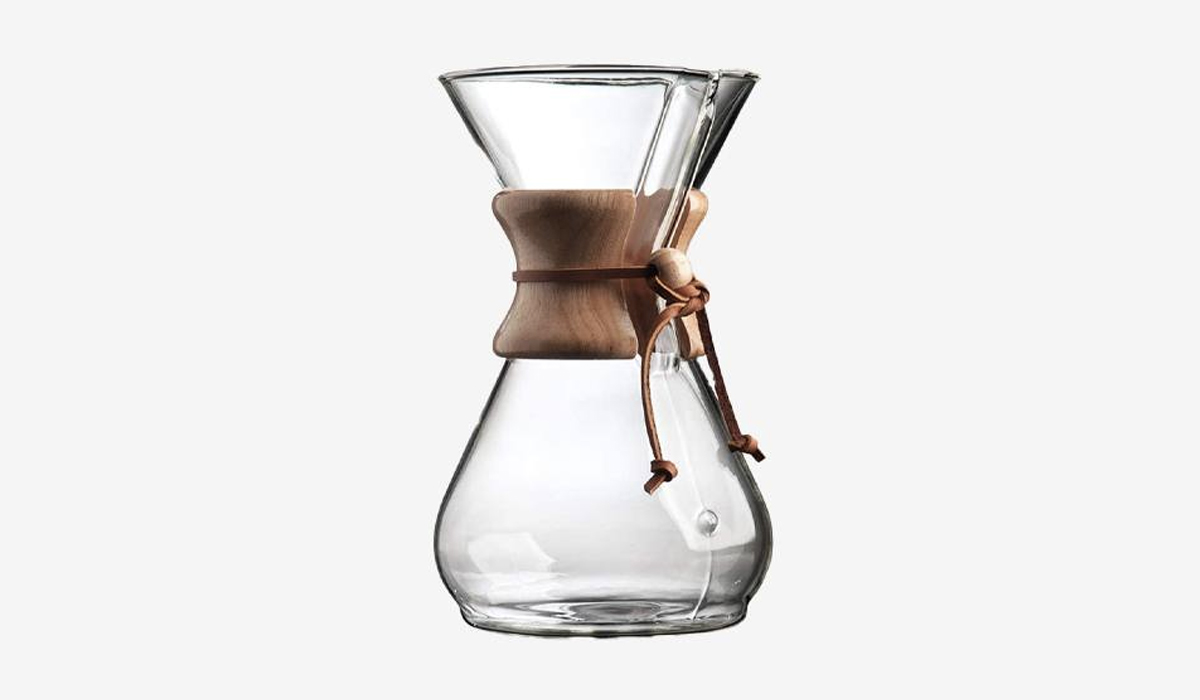
CHEMEX Pour-Over Glass Coffeemaker
You’d be hard-pressed to find a more iconic pour-over device than the CHEMEX glass pour-over coffee maker. It is an expensive option but historic and aesthetically pleasing. The wood collar and leather strap are easy on the eyes, comfortable in-hand, and will grab compliments whenever on display.
The 40-ounce capacity will keep your family caffeinated all day. Or if you’re an all-day coffee drinker, keep your CHEMEX on the stove over a low flame throughout the day. Do not try this on an electric stove.
It is dishwasher safe without the wood handle and is of the highest quality, non-porous borosilicate glass. Be sure to stock-up on CHEMEX’s paper filters specifically.
You may also be interested in some of these quality pod coffee makers from our list.

Hario V60 Ceramic Pour Over Coffee Maker
Hario V60 Ceramic Pour-Over Coffee Makers are a hit or miss. You love them, or you don’t. The reason is that the variables are hard to navigate, but once you’ve found your sweet spot, it’s a keeper. It’s ideal for one to three small cups of coffee.
The ceramic body retains heat throughout the percolation process, and the interior spiral ribs keep the filter away from the sides, allowing the coffee grounds to expand and bloom fully. Floral and fruit flavors won’t get lost in this pour-over coffee maker.
The cone shape and large, single hole in the bottom allow the coffee to drip straight into your coffee mug, avoiding the over-extraction typical of flat bottom devices. That said, the V60 requires special cone filters since it’s not flat-bottomed.
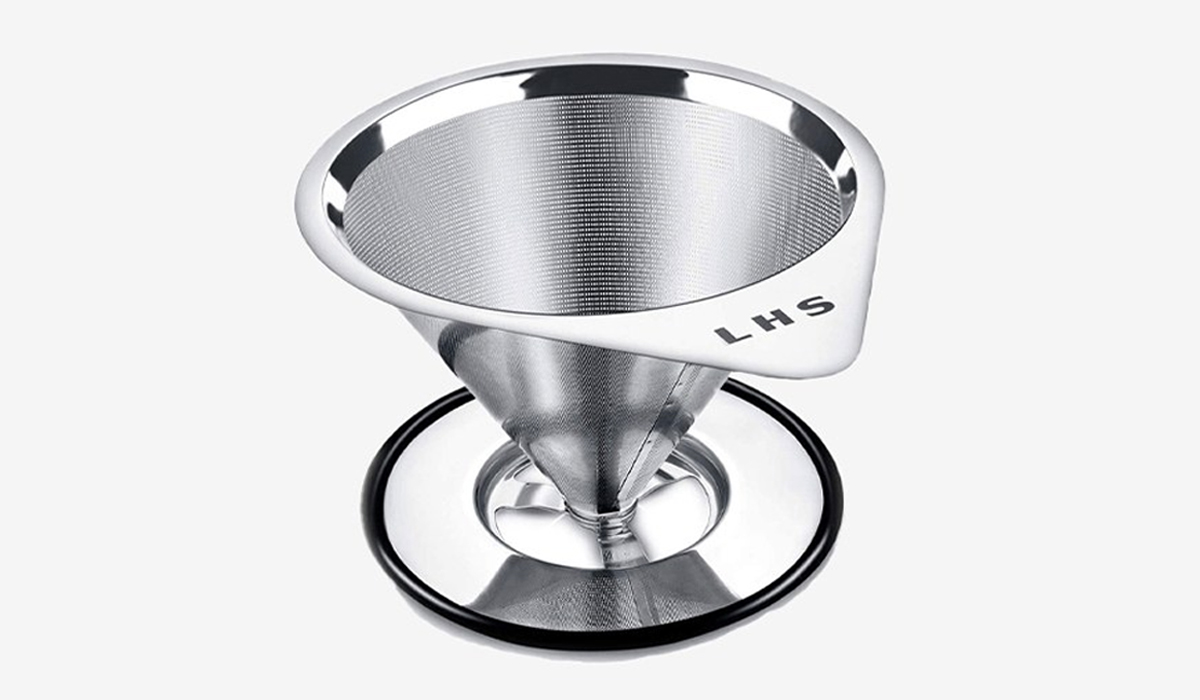
LHS Stainless Steel Pour Over Coffee Maker
The LHS Stainless Steel Pour Over Coffee Maker is an excellent choice for frequent flyers and weekend warriors. The non-slip design and removable stand allow you to use it in a decanter at home or over your favorite travel coffee mug, no filters necessary. It will also fit over most small travel canteens so that you can take one to two cups of coffee up your sunrise hike.
The stainless steel filter is a single layer versus a double layer, doing away with coffee residue and clogging that accompany double-layered filters. The pour-over coffee maker comes with a cleaning brush and a small price tag. Either rinse and wipe dry or place in the dishwasher at home.

Coffee Gator Pour-Over Coffee Maker
Coming in hot with another decanter and filter combo is the Coffee Gator Pour-Over Coffee Maker. The stainless steel dripper is a dual-layered reusable filter with a cool-touch filter grip for lifting it off the decanter without burning your fingers.
The decanter features a small pouring spout, BPA-free glass, and a generously handle for larger hands. It will hold 14 ounces, so if you’re looking for a smaller version of our best choice, this will be it. No filter required, and a quick rinse will have this pour-over coffee maker ready for tomorrow.
Be sure to check out our guide to the best single serve coffee makers that will provide you with your caffeine boost in no time.
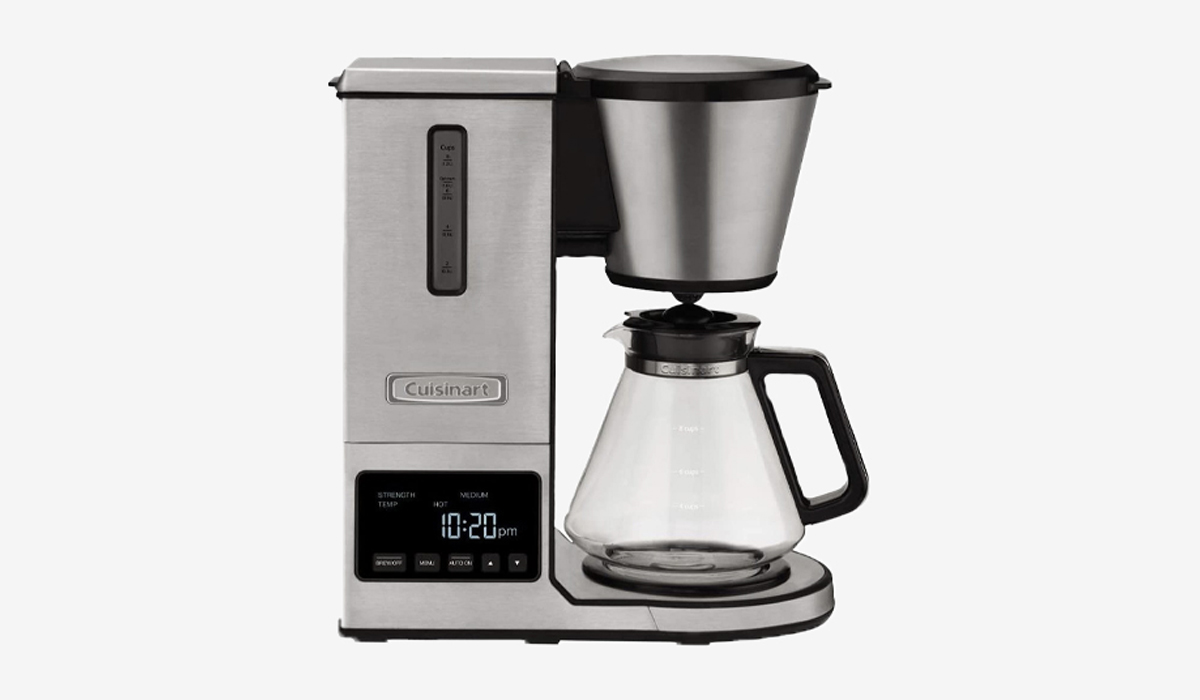
Cuisinart PurePrecision 8 Cup Pour-Over Coffee Maker
Straying from our exclusively manual controlled pour-over coffee makers we’ve started with, the Cuisinart Pure Precision 8 Cup Pour-Over Coffee Maker is an automated coffee machine, using pour-over concepts. If you haven’t quite dialed-in your manual pour-over recipe, this is a great choice. You’ll have control over temperature and flavor strength — mild, medium, or bold.
Water filters are built-in, and generic Melita #4 filters are needed but widely found in grocery stores. The brewer’s program will still pre-wet the ground to allow the grounds to bloom, although those gasses won’t escape due to the closed lid. For a fully customizable pour-over coffee without the manual labor, the Cuisinart PurePrecision is for you.
Here are some top Keurig coffee makers that all coffee lovers will appreciate. Check them out.
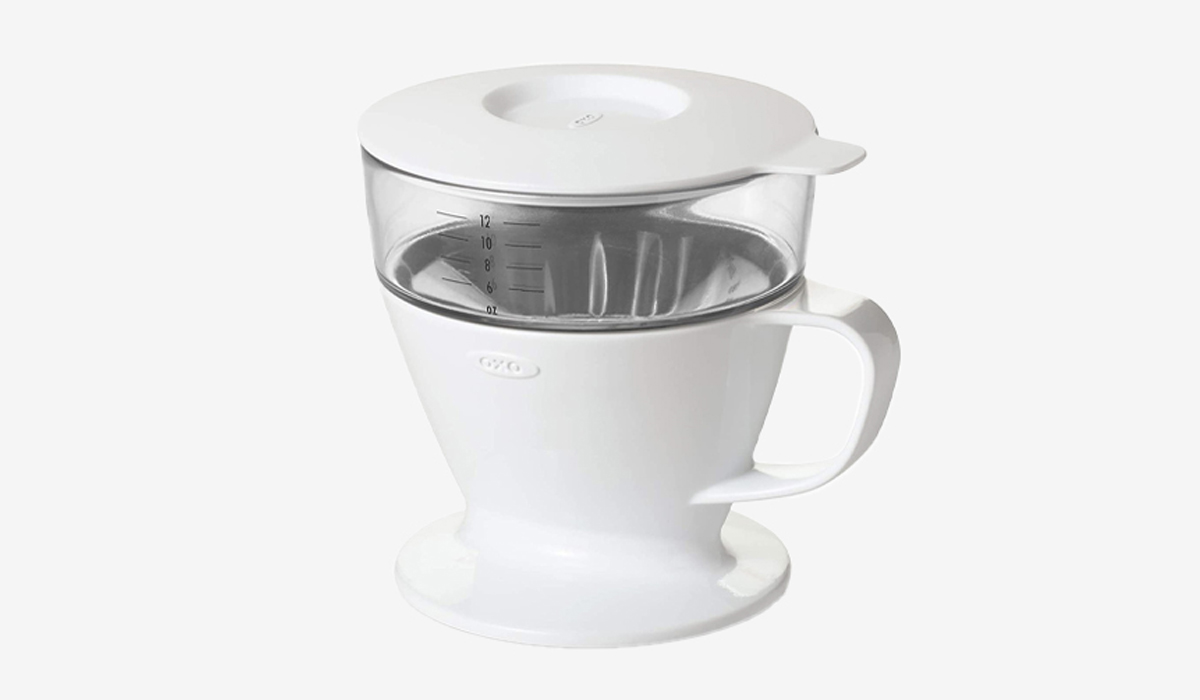
OXO BREW Pour-Over Coffee Maker with Water Tank
OXO is no stranger to kitchen accessories. And usually, those accessories have been well thought out to make your time in the kitchen, well, less time-consuming. The OXO Brew Pour-Over Coffee Maker with Water Tank is no different. It holds the same concepts as a traditional pour-over device but with the hassle of pouring.
The device’s base and cone look similar to a traditional plastic pour-over coffee maker but sitting on top is a 12-ounce auto-drip water tank with a heat retention lid. Pour in hot water from your kettle, and precise and various sized holes in the dripper base will mimic a manual pour. The pour-over coffee maker will fit on most coffee mugs, and if you want two cups, you’ll have to brew another batch. You can use generic Melita #2 filter, available in most grocery stores, and the heat retention lid doubles as a drip tray, saving you any cleanup!
And if you enjoy a cup of tea every once in a while, you will surely be interested in some of the quality tea makers from our list.
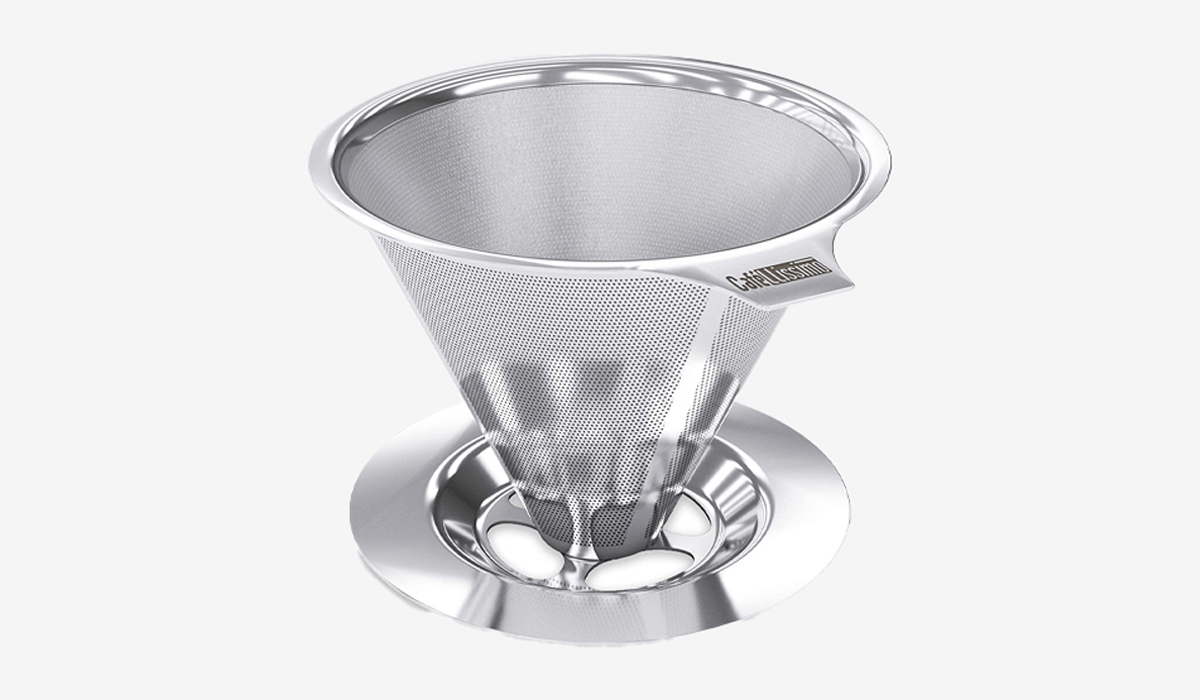
Cafellissimo Paperless Pour Over Coffee Dripper
Use the Cafellissimo Paperless Pour Over Coffee Dripper for swamped mornings at home or on-the-go. It’s perfect for one to two cups or one small decanter full. The stand will fit the majority of cups or to-go mugs, saving the decanter clean up.
High-quality mesh stainless steel is durable, dishwasher-safe, and easy to clean with a rinse under warm water. Bold flavors won’t get lost on this filter, ensuring your morning brew hits the spot. The dripper is a fine mesh screen, only allowing liquid into your mug, eliminating any bottom-of-the-mug sludge. This pour-over coffee maker is an excellent choice for eco-friendly, busy individuals.
For more cool additions to your kitchen collection, be sure to read our comprehensive guide to the best water pitchers.
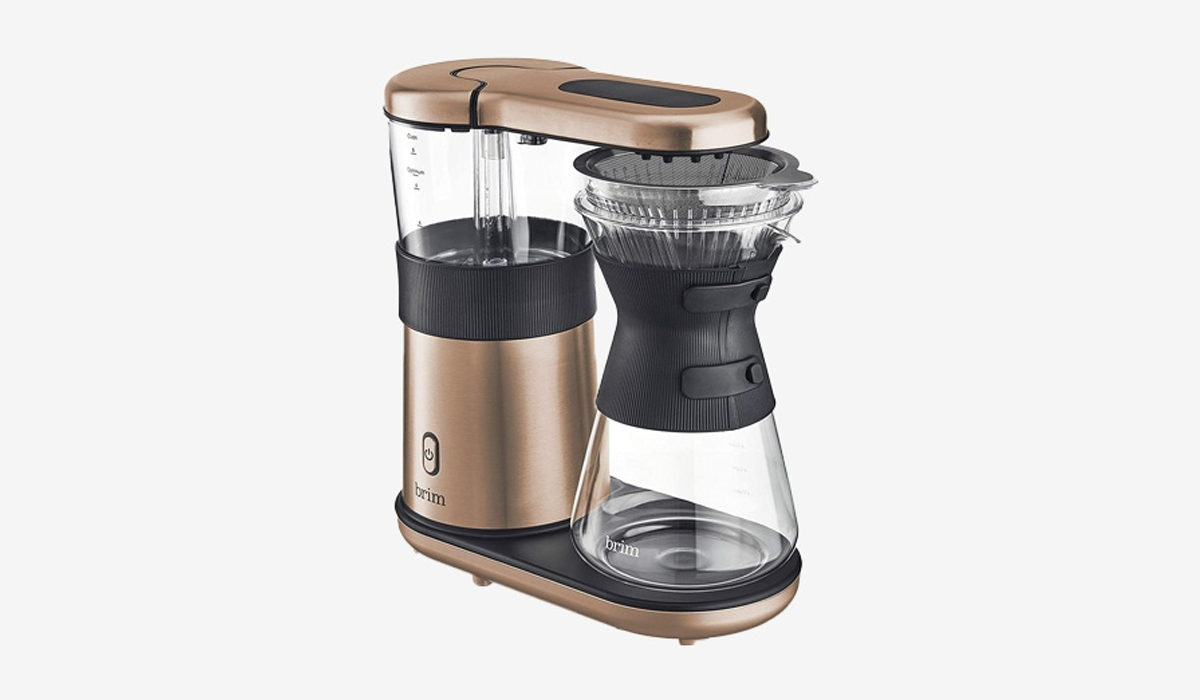
Brim 8 Cup Pour Over Coffee Maker
The Brim Pour-Over Coffee Maker is an eye-catcher. The satin copper finish and modern design will uplift any countertop. But that’s really the only place for it. While Brim’s device doesn’t afford you the portability of a traditional pour-over coffee maker, its integrated water tank means that you won’t need a kettle. Fill the water tank in the back, and the Brim will heat the water to an ideal temperature, a perfect bloom followed by a smooth, balanced coffee cup.
The water tank holds eight cups of water. It starts with the push of a button and brews in 2 to 3 minutes. Although you will sacrifice the ‘pour over’ ability, you’ll still have freedom with the grind size and the water-to-grind ratio. And you can simultaneously make breakfast.
The metal filter and decanter are easy to clean, and the plastic is BPA-free. There isn’t an option to turn off the warming pad, but it shouldn’t be an issue if making coffee for guests.
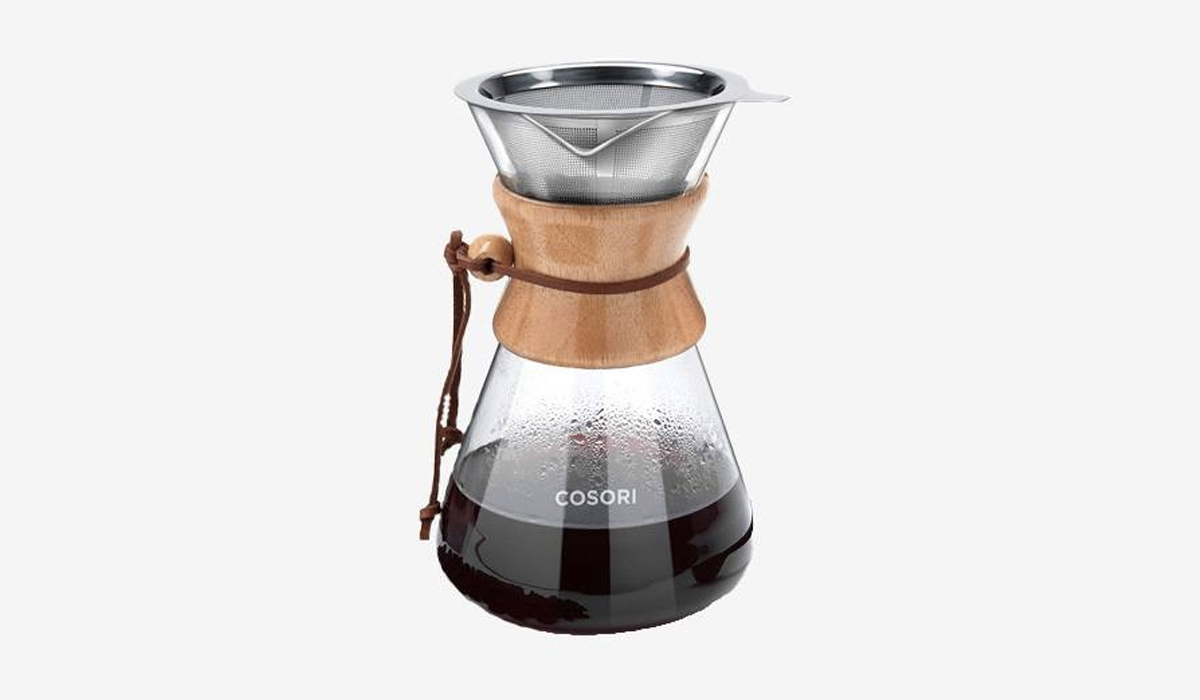
COSORI Pour Over Coffee Maker
If you’re feeling apprehensive about where to start on your pour-over journey, start here, with the COSORI Pour-Over Coffee Maker. Not only does it come with a stainless steel filter and a thermal resistant glass decanter, included is a manual with professional advice and a BPA-free measuring cup so you can skip the scale and calm your nerves.
The decanter with its wood collar and leather accent look similar to the CHEMEX, but a thinner hourglass shape and the filter differentiate the two. It can rest over a low flame or reheated if you lose yourself in conversation. It’s large enough for family campouts, fitting eight cups of coffee — plenty to go around. Both the filter and decanter (without the wood and leather) are dishwasher safe for hassle-free cleanup.
Pour-Over Coffee Maker Buying Guide & FAQ
Features to Look for in Pour-Over Coffee Makers
Material – The material of your device matters because of durability and heat retention. Stainless steel will be the most durable and only slightly rob heat from your brew. Plastic offers the same durability without the heat thieving material. If you tend to drop things in the kitchen, stay away from the ceramic or glass pour-over coffee makers. Glass has excellent heat-retention ratings. Some are even double-walled, so you can keep them over a burner on low heat if you a two-cup kind of person. Ceramic pour-overs retain heat as well as they rob heat; make sure you’re ready to heat your ceramic device before brewing.
Size – Are you making coffee for yourself or your whole tribe? Do you drink more than one cup of coffee in a sitting? Consider how much coffee you’ll need to brew before committing to a pour-over coffee maker that is too big or too small. Note that some international coffee companies measure one cup of coffee as 4 to 5 ounces. In the United States, typically, a single cup is 8 to 10 ounces, if not more.
Brewing Time – Brew time will be dependent on how much coffee you are making. Single cups should brew for about 2 to 3 minutes. Larger batches can take anywhere from three to five. You don’t want to exceed 5 minutes, though, to avoid the risk of bitter, harsh over-extracted coffee. Any quicker than 2 minutes, you’re brew will likely be sour, weak, and thin due to under-extraction.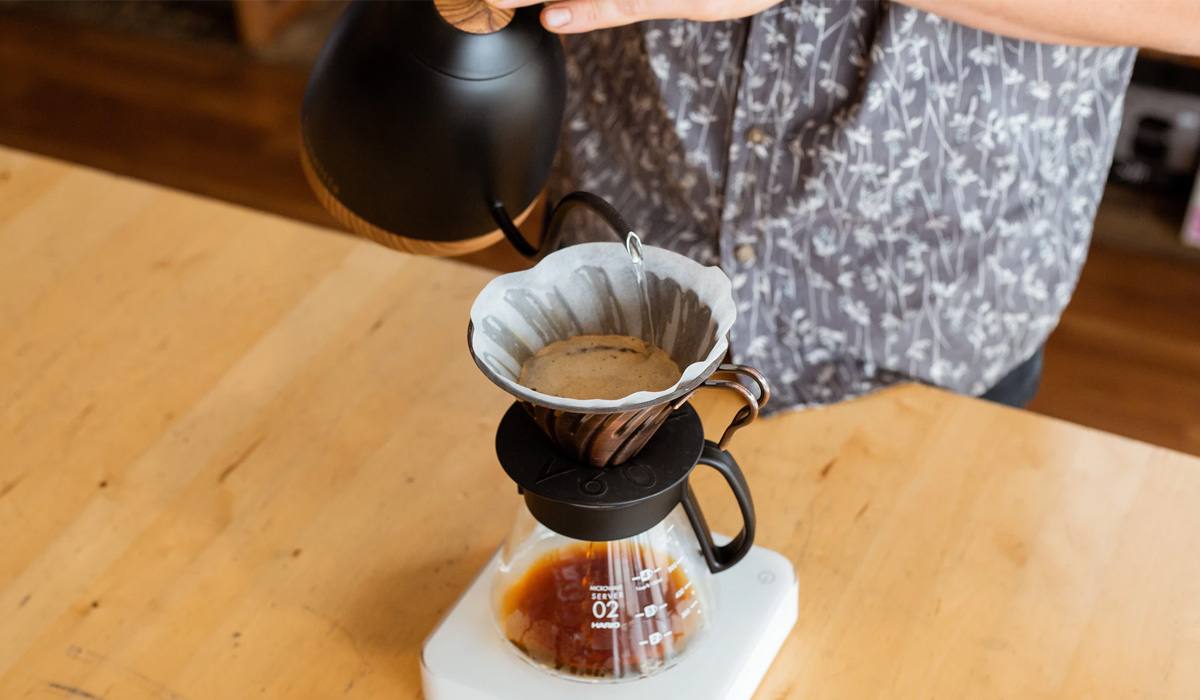
Portability – Because some pour-over devices are small and don’t need electricity, you’ll have the ability to take your pour-over coffee maker with you when you leave — be it camping, work, leisurely travel, or just across your kitchen.
Consistency – No coffee brew method will be as consistent as a commercial automated dripper you find in coffee shops and diners everywhere. Those machines brew quantity over quality. But pour-over coffee makers allow you to take chances with your coffee journey. And once you find the parameters — grind, time, heat — and perfect your pour, your fragrant cup of joe will be as consistent as the sun rising.
Accessories – The beauty of pour-overs is that you’re in charge of the brew — grind size, time, temperature, filter type. The variables are yours to control but manipulating them requires some extra tools. It’s important to note that when dialing-in your brewing process, only change one variable at a time. A minuscule modification can drastically alter the body, flavor, nose, and consistency of your coffee.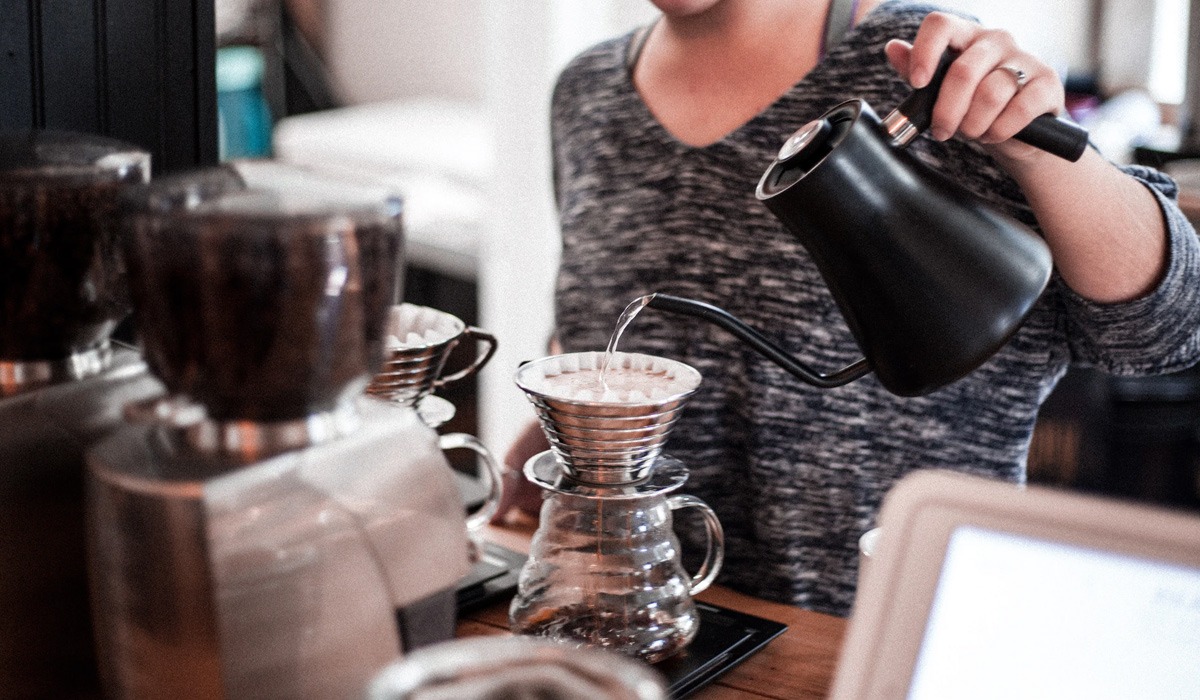
- A grinder – Grind size varies based on what type and the size of the device you’re using. If you have a finer grind size, you’ll want the water to have a shorter extraction or contact with the grounds and vice versa. But little tweaks can still be necessary. A home coffee grinder with burrs instead of blades allows you to make those small adjustments in real-time. It’s worth noting that coffee begins to lose flavor as soon as it’s ground, meaning pre-ground coffee won’t offer as colorful a taste. Not to mention, freshly ground coffee produces a nuanced, flavorful brew with an aromatic nose.
- A slow-pour kettle or gooseneck kettle – Precision is the MVP of pour-over brewing. And pouring water into your device from a regular kettle does not merit MVP-precision. Avoid unnecessary contact between water and the filter. Pour precise concentric circles from the inside of the grounds to the outer rim for even extraction. A slow-pour kettle is ergonomically balanced and has a long spout, a great tool for that perfect pour-over.
- Gram Scale – The ratios of coffee to water involved in pour-overs require more than an eyeball estimate. And the roast date and grind cause small differences in weight. Use a gram scale to weigh your dry coffee grounds in accordance with the output will keep your proportions balanced. Some advanced scales come with built-in timers as well.
- Thermometer – Heat is not as nuanced as other variables, but a thermometer ensures your water won’t burn the coffee. It’s easy enough to turn off the burner or kettle before the water starts a rolling boil. But the desired temperature recommended by the SCA (Special Coffee Association) is between 195 to 205 degrees Fahrenheit, which is just before boiling. Other accessories are necessary before a thermometer, as they are not as easy to manipulate without the tool.
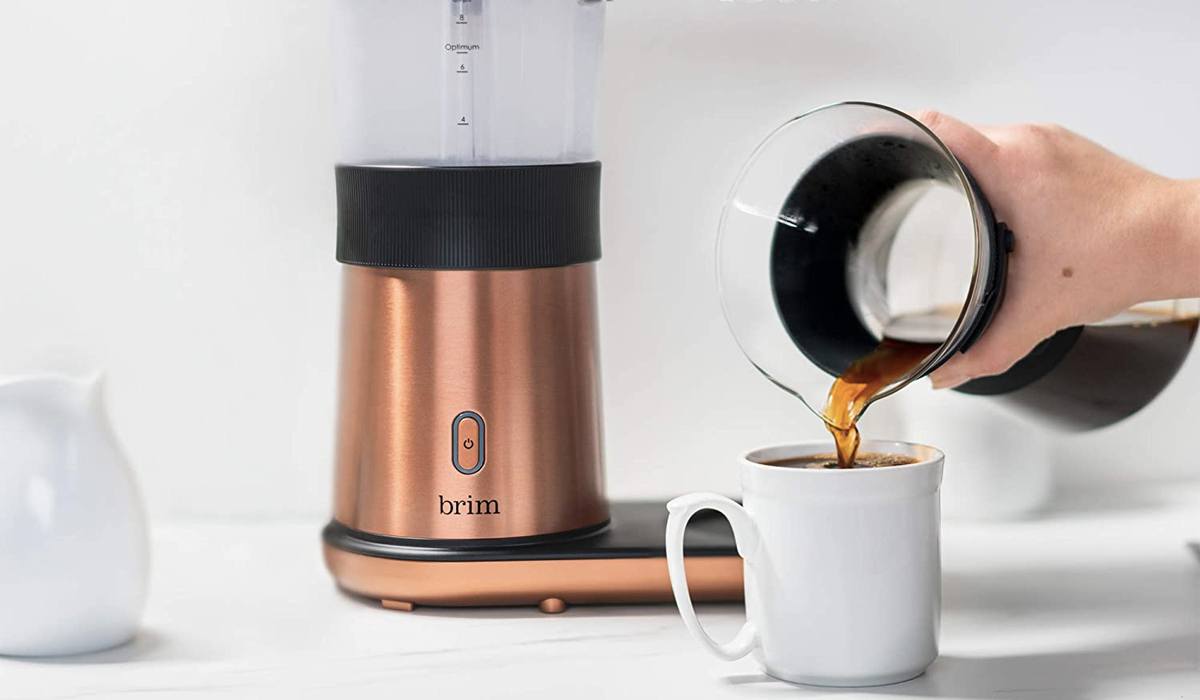
How To Brew Like A Barista
Here is your step-by-step guide on brewing the ideal cup of coffee using your choice of pour-over implements.
- Grab a bag of your favorite coffee beans, a mug, and your chosen pour-over device
- Fill your long-spout kettle with 330grams of water and heat until 195-205 degrees Fahrenheit
- Set the pour-over device on top of your mug and place a filter (if necessary)
- Set your grinder to a medium grind setting (adjust based on trial and error) and grind a portion of coffee beans then weigh out 20 grams of ground coffee.
- Once your water is at the optimal temperature, pour enough water over the empty filter to pre-wet the filter and heat the mug and pour-over device. Drain mug.
- Place the 20grams of ground coffee into the pour-over device and filter. Ensure the bed of coffee is evenly dispersed.
- Start your timer and start to pour, aiming for the center of the bed and pouring concentric circles over the coffee bed until the entire top layer has been saturated. Wait 30-45 seconds for the coffee to “bloom”.
- Once the gases have released and the bubbles stop in the coffee. Start to pour the rest of the water over the bed of coffee. Again starting in the center and pouring in even concentric circles. Try to stay within a quarter-inch of the filter to avoid any papery tastes.
- Continue pouring until all the water has been poured over the bed. Allow the pour-over device to drain completely into your mug. This should take approximately 2-4 minutes depending on the pour-over device and grind size of coffee. Remove the device, dispose of filter and grounds, and rinse the pour-over coffee maker.
Keep in mind the specs are for a 12oz cup of coffee, based on a 1:16 coffee to water ratio. Grind, water temperature and amount, and weight of coffee are all in your control to change and adjust based on personal coffee preference.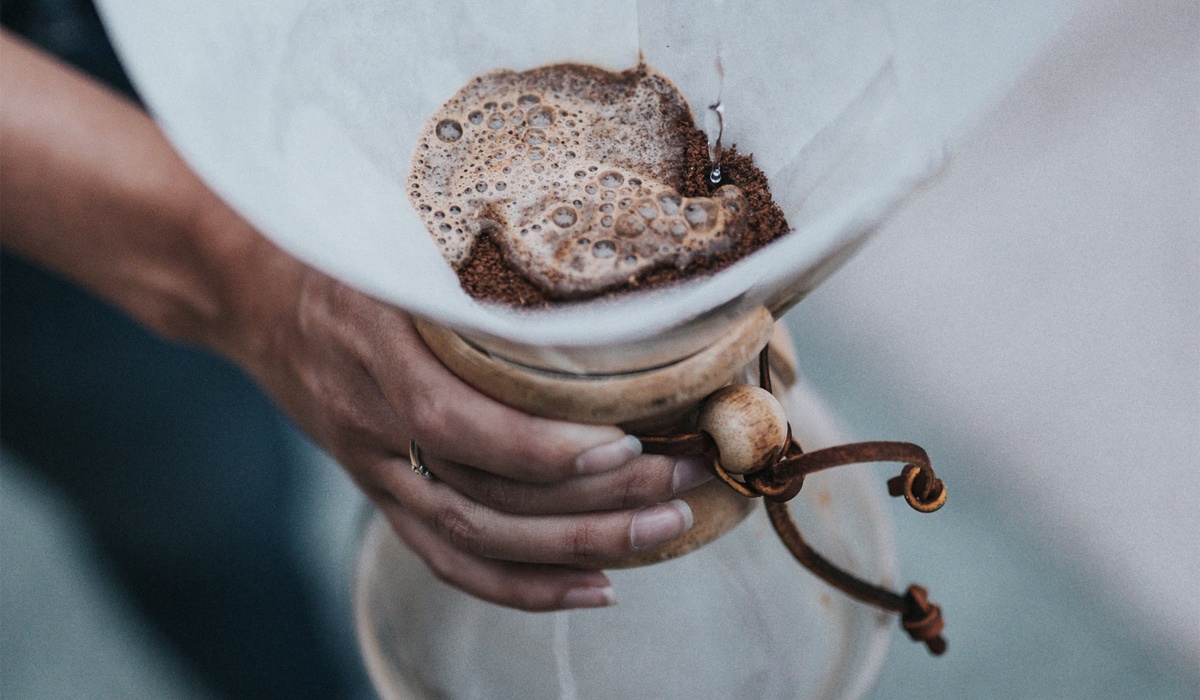
Pour-Over Coffee Maker FAQ
What is a pour-over coffee maker?
A pour-over coffee maker is typically a cone-shaped device with a rim or an hourglass-shaped decanter used with a filter to brew coffee using gravity. The device allows you to control water flow and quality. As the name suggests, it will pour water over the coffee grounds.
How does a pour-over coffee maker work?
Pour-overs employ an improved-upon percolation method, which uses gravity to pull water through coffee grounds evenly. Originally developed in the early 1900s, commercial pour-over coffee makers used percolators that robbed flavor and made the coffee taste bitter. Pour-over coffee makers bring out smooth, subtle flavors if done correctly.
Measure your water and heat it in a long-spout kettle as you gather the remaining materials. Now, let’s walk through each step as if we were brewing with a Hario V60.
You’ll place your Hario V60 over a mug, and set a paper filter inside the cone. Once your water is heated, pour some water over the filter before adding any coffee grounds to rid any initial papery taste. Place the coffee into the filter. To pour, start in the middle and work in an outward spiral until you’ve wet all the visible grounds without overflowing the filter. Wait 30 to 45 seconds and let the grounds ‘bloom’; you’ll see air bubbles pop to the surface. Blooming releases gasses that usually get trapped in automated brewers, which can create dull or acidic flavors. The blooming phase ends once the bubbles subside. Repeat the process if the first pour did not fill your cup.
During the pour-over, the water extracts coffee from the beans. Let the remaining water flow through the grounds, pulling coffee on its way down into your cup.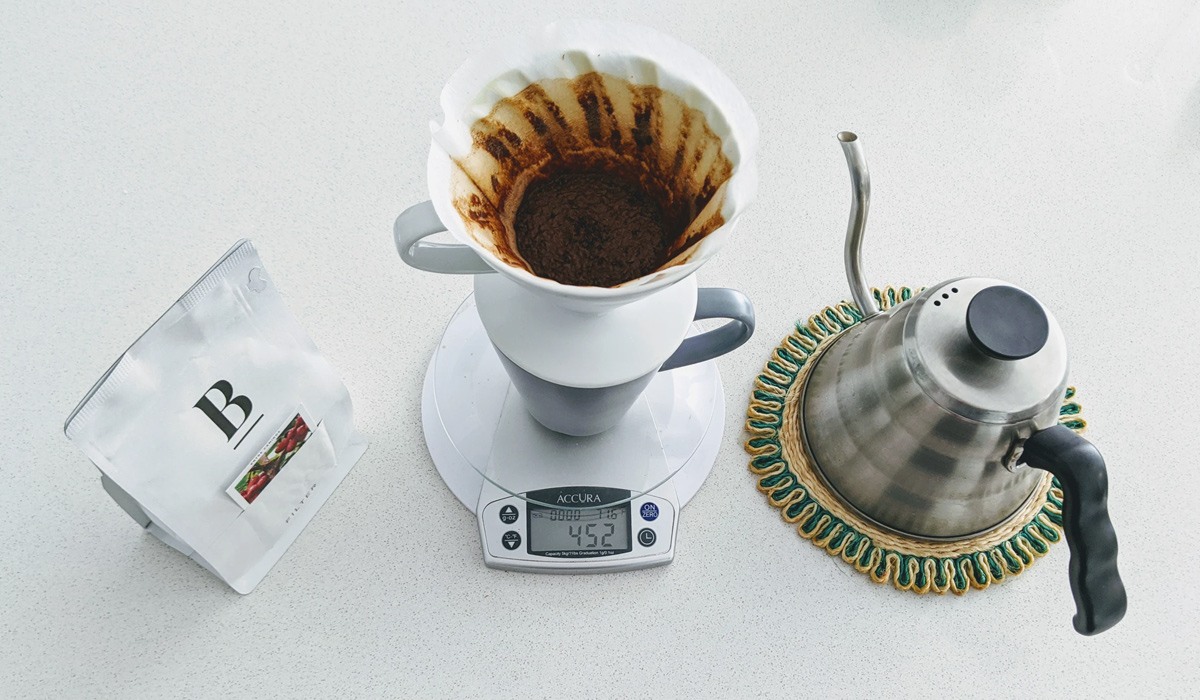
What’s so special about pour-over coffee?
Above is a generic explanation of what a pour-over is and how it works. But the unique aspect of pour-overs is that there really aren’t any rules. It’s all up to you. Sure, there are general guidelines, but pour-overs allow you to drive deeper into your coffee experience; it is a beautiful experience. The coffee industry is incredibly unique, with beans growing worldwide, pour-overs are a gateway into nuanced flavor profiles from small Brazilian farms or the depths of Africa. Pour-overs do not steal anything from proud, hard-working farmers; you taste it all. It may take practice and trial and error, but gosh darn, it’s worth it.
How much coffee do I use in a pour-over?
It depends on how much coffee you want. There’s a general ratio provided by the SCA — 16 grams of water per 1 gram of coffee. Ratios between 1:15 and 1:17 are within acceptable parameters. So if you want a 12-ounce cup of coffee, you’ll need just over 21 grams of coffee grounds. A scale is looking pretty useful now, huh?
How do you make pour-over coffee stronger?
You can make your pour-over stronger but adjusting the 1:16 water-to-coffee ratio. Err of the side of 1:15 if you’d like more robust coffee and vice versa if you’d like a weaker cup of joe.
Adjusting the grind coarseness won’t affect the power of the coffee’s flavor, but will affect the lushness/mouthfeel, indicative of the degree of extraction.
